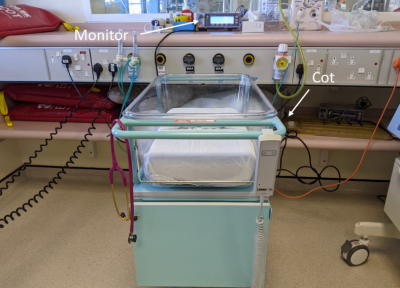Acute Assessment Unit
About us
The Neonatal Unit cares for sick and premature babies. Our unit is designated as a Level 2 Local Neonatal Unit within the South London Neonatal Network. We provide intensive care, high dependency care and special care.
For those babies likely to be born before 27 weeks gestation (28 weeks for twins), care is transferred to St George’s Hospital as they specialise in extreme prematurity. We aim to do this prior to delivery. Babies who require ventilation over 48 hours or need specialist or surgical input are likely to have care transferred to St George’s or another tertiary unit. As soon as your baby is well enough, they will return to Kingston Neonatal Unit for ongoing care.
Each experience is different and the care we deliver is tailored to your baby’s needs to ensure the best possible outcome and give the best experience for all the family.
Parents are involved and are updated daily on the ward round and are fully involved in the decision making about care and treatment.
In addition to the doctors and nurses, we also have additional team members to support your baby. These include dieticians, physiotherapists, speech and language therapists, pharmacists and our own Infant Feeding Team.
Visiting
On the neonatal unit, we regard all parents as partners in care. Therefore, we have open visiting for both parents and carers.
When a nursing handover or a ward round takes place, headphones are given to parents to maintain confidentiality without parents having to leave the nursery. If one parent is not able to visit, then a second main carer can be nominated to visit.
Please see the main visiting someone in hospital web pages to see general information about visiting. We have our own visiting policy which is that parents and siblings are welcome 24 hours a day. Other visitors are welcome between 2-7pm. Unfortunately, children under the age of 16 cannot visit. Only two people are allowed to visit each cot space at any one time.
Marie Richter, Neonatal Unit Matron, is our Neonatal Safety Champion. Find out more about our Maternity Safety Champions here.
Machines, equipment, alarms, and noises in our Neonatal Unit
On the neonatal unit your baby may be attached to equipment to help with extra monitoring and support with breathing and other treatments.
This might include machines to help with monitoring your baby’s breathing, oxygen levels, heartbeat, and to give medicines and treatments. This also includes ventilators and other systems to help breathing.

Incubators
This is a system to keep your baby warm and without needing any clothes if your baby needs extra close monitoring. Oxygen and ventilation support can be put into the incubator if needed.
Ventilators
This machine helps your baby to breathe, and if necessary, can control exactly how much air and oxygen goes in and out of your baby’s lungs.
Monitors, screens and bleeps
Many machines and monitors (screens) make bleeping noises and alarms. These are to monitor how your baby is breathing, the oxygen levels (“sats”), the heartbeat. A small probe is attached to the hand or foot and sends the information to the monitor. Often the monitors can bleep when the baby moves as the signal to the monitor stops working.
Most bleeps are normal and just for information, and the nurses are trained to respond to the alarms.
Pumps
Many babies need medication that goes straight into the babies blood vessels (veins). This is given by a pump which delivers medication or fluid as your baby needs.
On the neonatal unit your baby may be attached to equipment to help with extra monitoring and support with breathing and other treatments.
This might include machines to help with monitoring your baby’s breathing, oxygen levels, heartbeat, and to give medicines and treatments. This also includes ventilators and other systems to help breathing.
